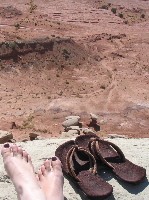Day 3 at the 210th AAS: I Am So Tired
Yesterday was a slow day for me. While there were several individual talks I was interested in going to, there weren't any sessions I was willing to stay in for more than half an hour. But since yesterday was the first day my poster was up, I spent most of my time hanging out in the poster room. The two posters on either side of me were getting a lot more traffic. One was simply an interesting idea involving the gravitational lensing of gamma ray bursts by primordial black holes as will be viewed by GLAST; instead of a "classical" lensing, an interference pattern should be seen in the signal. While the probability of such an event is low (10-5) and contingent on which model of primordial black holes and subsequent destruction you take, it is still a neat idea. On the other side of me was a poster about the dynamical origins of the local Hercules stream—they think it's due to a dynamical ripple thanks to the Galactic bar. People like hearing about the structure of the Milky Way, so this project was one of the three discussed at the press conference I attended (as an interested listener) in the late morning.
In the afternoon, also in the exhibit hall, I got the chance to go inside the Star Lab they have set up in the corner of the hall. For the low low price of $15,000 you too can own the ultimate tent for camping out in the living room. The Star Lab is essentially a portable planeterium, a big grey plastic bubble that you crawl into, with the stars projected onto the inside surface. The inside of the bubble goes up to 10 feet high and is large enough to lay down in while the presentation is being given. The presentation I was given focused on Hawaiian navigation: how did the Polynesians and Micronesians find Hawai'i? Apparently there was this big controversy about four decades ago over whether or not the Hawaiian islands were "stumbled upon" or purposely found. I don't really understand how you can purposely go find something you do not know (or have reason to believe) exists, but anyhow. In the 1970s a group called the Polynesian Voyaging Society formed themselves and learned how to navigate cross-ocean using no instrumentation. They built a few double-hulled canoes and went from Hawai'i to Tahiti... with no instrumentation. In canoes. We re-learned all of the familiar constellations and asterisms with their Hawaiian legends, and a few of the more southern constellations I have never seen with my own eyes.
Today is the last day of the conference, and things will be pretty much done by lunchtime. I have no idea of details yet, but I'm hoping to find some people to explore the island with... I've gotten only a few blocks from the hotel and convention center since arriving here on Sunday.


4 comments:
It just occured to me: 210th AAS? These aren't yearly, right?
Nowadays, the meetings are semi-annual; the "big" meeting is the winter one, in January, and the smaller one (like this one) is in May or June. The AAS was founded in 1899, with the first meeting being in Williams Bay, Wisconsn (!!!) in September of that year. 1920 was the first year with two meetings, and some years have seen three meetings (think post-Sputnik).
Mollishka -- I saw your comment on Sunclipse about not being able to post math notation on Blogger. A while back I hacked up a JavaScript dealie for this exact situation. Here it is, with links to other relevant packages. I make no promise of maintaining it indefinitely, but it's been up since Christmas and I'll be happy to hand anyone the source code. Hope you find it useful.
Is it possible that ejections
from galaxy interiors under the influence of rotation are
the cause of spiral arms?
Post a Comment